How to Fix MSI Motherboard Error 99
Some PC users using MSI motherboards are reportedly unable to boot up their computer. The error code 99 appears in the bottom-right corner of the screen and doesn’t go away regardless of the hardware changes that the user tries to make.
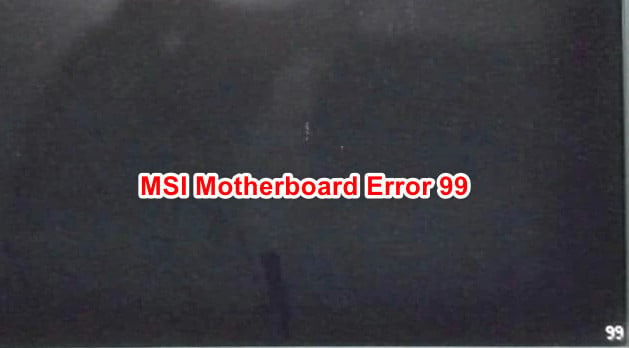
After investigating this particular issue, it turns out that there are several different scenarios that might cause this particular error code. Here’s a shortlist of potential culprits:
- Corrupted Kernel Temp Data – As it turns out, you can expect to see this error message if your low-level software contains corrupted temp data that is preserved in between booting sequences by the CMOS battery. If this scenario is applicable, you should be able to fix the issue by temporarily removing the CMOS battery long enough to allow the system to ‘forget’ the temporary data.
- BIOS / UEFI Inconsistency – According to some affected users, this problem can also occur when a previously enforced setting (usually related to the voltages) is making the system so unstable that’s no longer able to boot up. In this case, the quickest fix is to return your BIOS / UEFI settings back to their default values.
- Insufficient PSU – If you’re using a low-end PSU, it’s entirely possible that the reason why you’re seeing the 99 error code is that your system is unable to provide enough power to satisfy each connected component and peripheral. In this case, you can fix the problem either by disconnecting non-essential peripherals or by upgrading to a more powerful PSU.
- I/O issue with USB ports – In case you’re using an older MSI model that still has PS/2 ports for keyboard and mouse, chances are you’re dealing with a fairly common glitch that occurs when USB-based peripherals are used. If this scenario is applicable, one quick workaround is to connect legacy peripherals and remove their USB equivalents to get past the 99 motherboard error.
- Hardware issue – Under certain circumstances, you can also expect to see it his error in instances where a short-circuit or other types of damage to your motherboard is causing this type of critical crash. In this case, the only thing you can do is send your motherboard for repairs or try to get a replacement if you’re still under warranty.
Method 1: Clearing the CMOS battery
As it turns out, one of the most common reasons why you can expect to see the 99 error code with MSI motherboards is an inconsistency with the UEFI or BIOS settings. In most cases, this problem will occur due to temporary data that are being preserved in between startups by the CMOS battery (Complementary Metal-Oxide Semiconductor).
If this scenario is applicable, you should be able to fix the problem by opening your PC case and temporarily removing the CMOS battery in order to clear any information that is preserved between computer boots.
If you don’t know how to clear the CMOS battery, follow the instructions below for a step-by-step guide on doing this:
Note: The instructions below are only applicable for desktop PC. If you’re encountering this problem with an MSI laptop, removing the CMOS battery is far more complicated and will require you to take everything apart before you’ll be able to reach it.
- Turn off your computer and unplug it from the power source.
Note: It’s not enough to power off your computer conventionally – You’ll also need to unplug the power cable. - Next, remove the side cover of your PC and equip yourself with a static wrist band if you have one at the ready.
Note: A static wristband will ground you to the frame of your computer, which is necessary if you want to eliminate the risk of a short circuit that might damage the internals of your computer. A wristband will ground you to the frame of the computer which will even out the electrical energy propagated throughout the PC. - Once you’re using the proper equipment and you successfully managed to open up your Computer cases, take a look at your MSI motherboard and identify the CMOS battery. When you see it, use your fingernail or a non-conductive object to remove it from the slot.
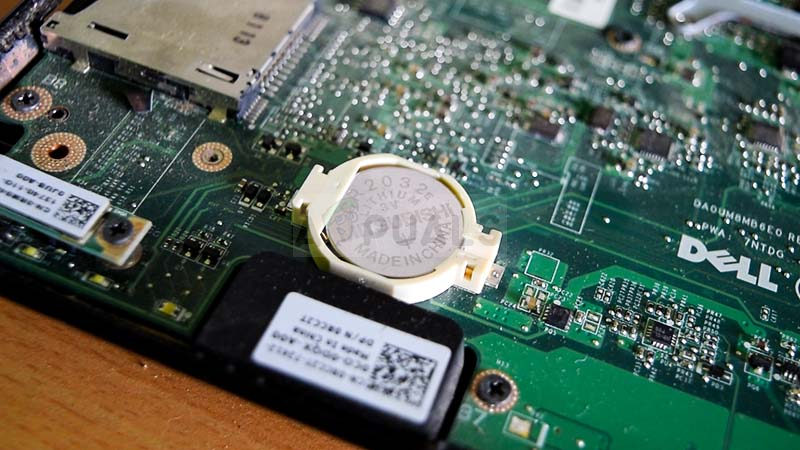
Removing the CMOS battery - Once you have successfully removed the CMOS battery, wait for 10 seconds or more to ensure that your motherboard ‘forgets’ the information the CMOS battery was previously helping it preserve.
- After the time period has passed, insert the CMOS battery back into its slot and put the side cover of your PC back into place before reconnecting power and booting up the computer normally.
- Start your computer and see if this method allows you to get past the 99 error code thrown by your MSI motherboard.
If the same problem still remains, move down to the next potential fix below.
Method 2: Resetting BIOS / UEFI to default (if applicable)
If this problem is intermittent (sometimes it allows you to get past the initial screen), you might be able to fix this problem by resetting your BIOS (Basic Input / Output System) or UEFI (Unified Extensible Firmware Interface) settings.
If this problem is caused by a BIOS or UEFI glitch or setting that makes the system unstable, you should be able to fix the issue by resetting the BIOS / UEFI menu to the default values. This potential fix was confirmed to be effective by a lot of affected users.
However, keep in mind that depending on the low-level type of software that you’re using, the instructions of resetting them will be different.
Because of this, we’ve put together 2 different sub-guides that will walk you through this process regardless if you’re using BIOS or UEFI:
A. Resetting the BIOS Settings to the Default
- Power up your PC and repeatedly press the Boot key (Setup key) immediately after you see the first startup screen. If you don’t know which key is your boot key, it should be typically displayed on the bottom of the screen.
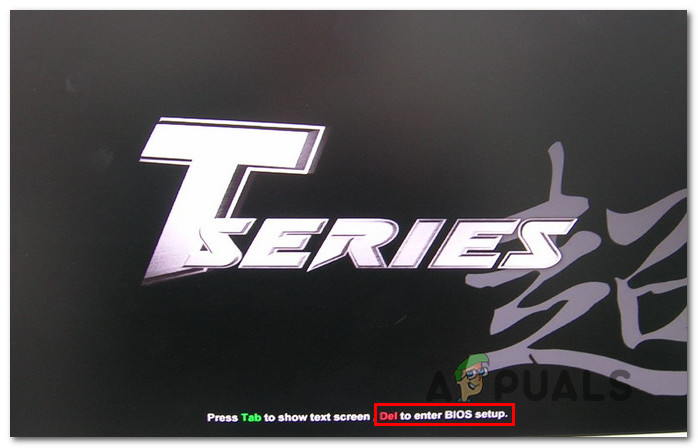
Pressing the Setup key to enter BIOS settings Note: If the setup screen is not displayed on the screen, search online for the boot key that’s specific to your motherboard model. In most cases, the setup (boot key) is either the Del key (Dell Computers), the Esc key, or one of the F keys (F1, F2, F4, F8, F12).
- Once you’re finally inside the BIOS settings, look for a menu named Setup Defaults (Reset to Default, Setup Default, or Factory Default). Next, use the Load Setup Defaults option to revert your settings back to the default values.
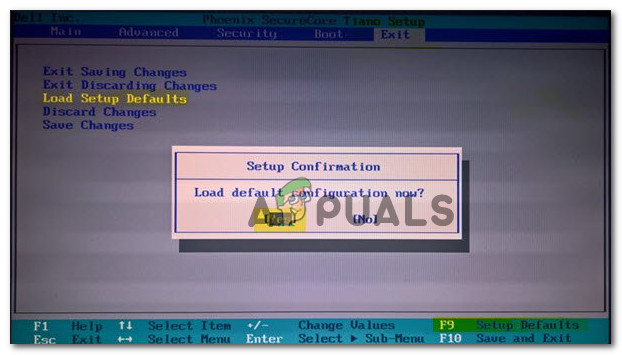
Load default system configuration - Save the changes you just made before exiting the BIOS settings and wait for the next startup to complete.
B. Resetting the UEFI Settings to the Default
- If you’re unable to get past the initial screen, force 3 consecutive startup sequences (turn off your PC while it’s booting up) in order to force it into the Recovery menu.
- Once your computer finally boots into the Recovery menu, go to Troubleshoot > Advanced, then click on UEFI Firmware Settings.

Accessing the UEFI firmware settings - Finally, click on the Restart button and confirm your choice. After you do this, your computer will restart directly into the UEFI menu.

Restarting the computer directly into the UEFI Setup - Next, your computer will boot up directly into the UFI settings. Once you’re finally inside, look around for the Restore menu and choose Restore Default. Keep in mind that the default location and name of this option will vary depending on your type of UEFI and your motherboard manufacturer.
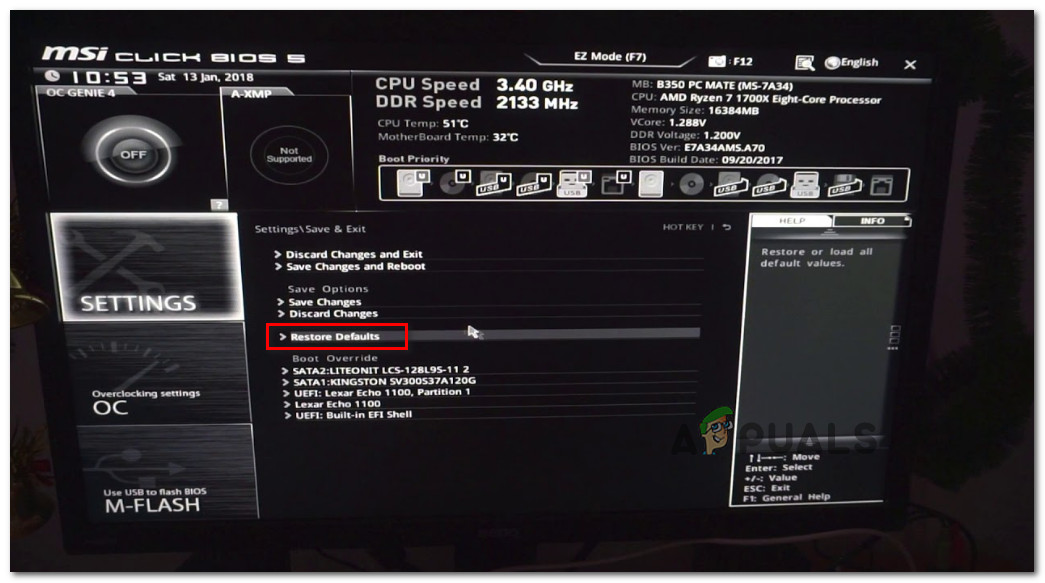
Restore UEFI settings to the defaults - At the confirmation prompt, confirm the reset of your UEFI settings and see if the next startup will occur without the same 99 error code.
If you already tried resetting your BIOS or UEFI settings and you’re still seeing the same MSI motherboard error code, move down to the next method below.
Method 3: Removing peripherals (if applicable)
The 99 error code with MSI motherboards is often associated with an error related to failing USB devices connected via front-panel ports (wireless keyboards, hard drives, printers, USB hubs, etc.)
And as it turns out, some affected users that were also struggling with this issue have managed to fix the problem after disconnecting certain unnecessary peripherals. Some affected users have confirmed that the issue went away after they’ve disconnected an external HDD / SSD, while others managed to avoid the 99 error code by disconnecting their USB-powered headset.
The fact that these workarounds were effective seems to suggest that you might also be dealing with an I/O (input/output) issue or it might be a classic case of an insufficient PSU (Power Source Unit) that’s unable to supply enough power for every component that’s currently connected to your PC.
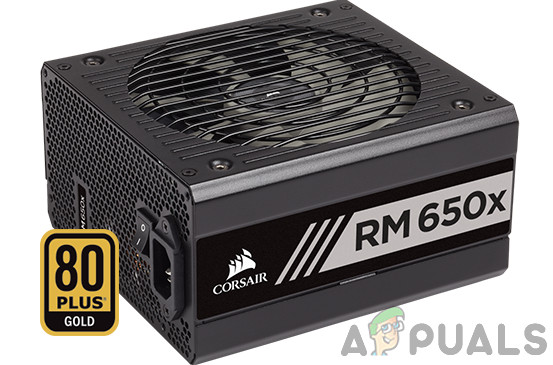
If you don’t want to upgrade your PSU to a new unit with a bigger capacity, our only option is to disconnect every non-essential device that’s currently utilizing energy supplied by your PSU.
If you already tried removing every non-essential device that’s connected to your PC and you’re still facing the same 99 error, move down to the next method.
Method 4: Connecting mouse and/or keyboard via PS/2 ports
Keep in mind that if you’re using an older MSI motherboard that still has PS/2 slots, you might be dealing with an I/O issue brought about by peripherals connected via USB. Weird enough, some affected users have managed to fix the problem by disconnecting their USB and keyboard and connecting older peripherals via the legacy PS/2 port.

This might seem like a weird fix, but there are a lot of user reports confirming that this method successfully allowed them to get past the 99 error code triggered by MSI motherboards.
So if you have PS/2 slots on your motherboard and you still have legacy peripherals to connect them to the slots, do it and see if you can avoid the 99 error code entirely.
On the other hand, if this scenario is not applicable, move down to the final potential fix below.
Method 5: Send it for replacement (if applicable)
If none of the methods above have worked for you, you should start considering the fact that you might be dealing with a short circuit that ended up messing up with your internals.
Several users that found themselves in a similar situation have managed to fix the issue by sending their motherboard (or entire PC) in for replacement if they’re still under warranty.
In case your warranty has expired and you have a different motherboard that’s compatible with your CPU, GPU, and RAM, you can move them to the other motherboard and see if your computer boots up without issues.





